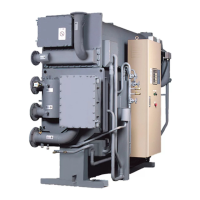5-6
6. Typical water treatment
Even if make-up water for cooling water meets the water standards, the water quality gets worse by
its concentration, therefore the following water treatment is necessary. To varying degrees, chilled
water also requires this treatment. In case of an application of concrete heat storage tank, special
attention should be paid to water treatment.
① Periodic and continuous blow down by make-up water
② Automatic blow down by electric conductance
③ Addition of the anticorrosive
④ Slime control
⑤ Periodic water analysis
Overhaul the water headers periodically, check heat transfer tubes and clean them as necessary.
5-3-2. Water Treatment for long term shut down
Perform the following treatment during long term shut down with no-circulation of chilled/hot water,
cooling water in the Chiller. Consult the service agent for details.
(1) Cooling water
Keep the cooling water full in the Chiller. (Wet lay up)
In case the freezing of cooling water is likely to occur, drain it from the Chiller. (Dry lay up)
Operation of a valve of the chiller is different between wet lay up and dry lay up.
Wet lay up
1. Discharge cooling water from its discharge port on the cooling water outlet.
2. Check the holding water quantity and decide the anticorrosive quantity so that the mixture
fraction is appropriate. Pour anticorrosive into the water.
3. Fill up the absorber/condenser.
4. Operate the cooling water pump until anticorrosive is evenly mixed.
5. Close the isolation valves of inlet and outlet on the cooling water line.
Dry lay up
1. Discharge cooling water from its discharge port on the cooling water outlet.
2. Remove the scale and/or slime adhesion in the tubes by nylon brush cleaning. (If scale
and/or slime cannot be removed, perform chemical cleaning.)
3. After sufficient washing, pour anticorrosive into the water, and circulate it for 30 minutes or
more. (The concentration of anticorrosive should be even.)
Steam consumption
(%)
Rise in chilled water
temperature deg.C
Decreasing ratio of
cooling capacity (%)
Fouling factor(m
2
・hr・
o
C/kcal)×10
-4
Fouling factor(m
o
C /kw)×10
-
0.2 0.4 0.6 0.8 1.0 1.2
Scale/Slime(mm)
For example, if 0.6mm of scale clings to
tube, cooling capacity drops to 76%, and
chilled water temperature rises by 2
o
C
(3.6
o
F) and fuel consumption rises by 23%.
A: In case of constant cooling capacity
(Ratio at rated fuel consumption)
B: Rise in fuel consumption
C: Lowering of cooling capacity
(In case of constant chilled water
temperature)
D: Rise in chilled water temperature
(In case of constant cooling capacity)

